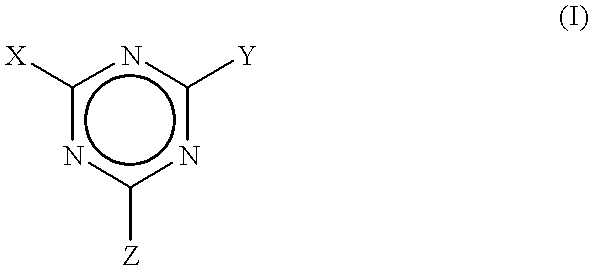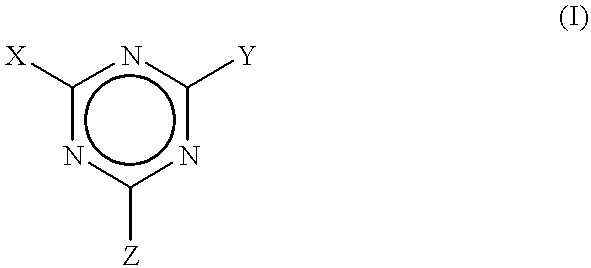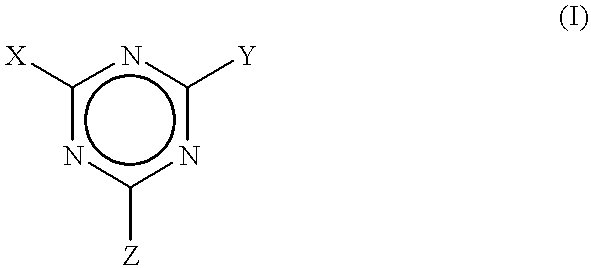Process to scavenge amines in polymeric compounds by treatment with triazine derivatives and compositions therefrom
a technology of triazine and polymer compounds, which is applied in the direction of biocide, organic chemistry, plastic/resin/waxes insulators, etc., can solve the problems of poor distribution of inhibitors, deleterious impact on rubber compositions and intended purposes, and unsuitable use of polymeric compositions. to achieve the effect of increasing the purity of polymeric compositions
- Summary
- Abstract
- Description
- Claims
- Application Information
AI Technical Summary
Benefits of technology
Problems solved by technology
Method used
Image
Examples
examples 1-9
To exemplify the invention, several triazines were added as amine scavengers within polymeric rubber compositions that were compounded. The polymers were prepared from amine initiators. The compounded polymers were analyzed in both the uncured and cured states for residual amine to determine the level of effectiveness of the treatments, i.e., compounding with the triazine scavengers. The levels of residual amine remaining after compounding the rubber with these derivatives were reduced by an amount ranging from about 40 to about 100 percent of that found in the absence of treatment.
Specifically, a styrene-butadiene copolymer was prepared by initiation with the lithium salt of hexamethyleneimine (HMI). At the end of polymerization, the cement from the polymer was coagulated in isopropyl alcohol, in the presence of di-t-butyl-p-cresol, at about 0.2% by weight of the rubber, and an antioxidant. A sample of the raw, dried polymer contained about 1-10 ppm of amine impurity.
For analysis, ...
example 1
that was a sample of the composition without any additive that was cured for 30 minutes at 1 65.degree. C and contained about 1.2 ppm of free amine. In Example 2, an uncured stock of this formulation that was mixed with 1 part by weight of 2,4,6-triphenoloxy-1,3,5-triazine (also known as triphenyl cyanurate) per hundred parts by weight of rubber (phr) contained about 5.2 ppm of free amine prior to curing. This equates to a reduction of amine content of about 44 percent by weight. However, no free amine could be detected in the stock containing the triphenyl cyanurate after it was cured for 30 minutes at 165.degree. C. This equates to a 100 percent reduction of the residual amine content. Example 3 provided about a 97 percent reduction in residual free amine in a test of the uncured, compounded stock, and essentially complete elimination of free amine in the cured stock. Cyanuric chloride also markedly retarded the cure rate.
examples 4-9
were aimed at probing structural factors in the triazines. They showed that triazines containing alkyl- or aryl-substituents can also be very effective as amine traps. In fact, free amines in the cured compounds of Examples 6 and 8 were reduced to lower than detectable levels. This corresponded to decreases in the free amine levels of from about 70 to about 93.sub.+ percent. They also showed that the triazines work at levels at least as low as about 0.5 phr. The compounds of Examples 5 and 7, (Poly)chlorinated pyridines and pyrimidines, although superficially similar to triazines, are considerably less effective than the triazines as traps for residual amines. They decreased the level of residual free amine by only about 5 to about 15 percent in the uncured samples, and only up to about 22 percent in the cured samples. Examples 6 and 8 exhibited decreased cure rates. Example 8 showed very little reduction in cure rate, and Example 9 confirmed the outstanding effectiveness of cyanuri...
PUM
| Property | Measurement | Unit |
|---|---|---|
| weight | aaaaa | aaaaa |
| weight | aaaaa | aaaaa |
| weight | aaaaa | aaaaa |
Abstract
Description
Claims
Application Information
 Login to View More
Login to View More - R&D
- Intellectual Property
- Life Sciences
- Materials
- Tech Scout
- Unparalleled Data Quality
- Higher Quality Content
- 60% Fewer Hallucinations
Browse by: Latest US Patents, China's latest patents, Technical Efficacy Thesaurus, Application Domain, Technology Topic, Popular Technical Reports.
© 2025 PatSnap. All rights reserved.Legal|Privacy policy|Modern Slavery Act Transparency Statement|Sitemap|About US| Contact US: help@patsnap.com



